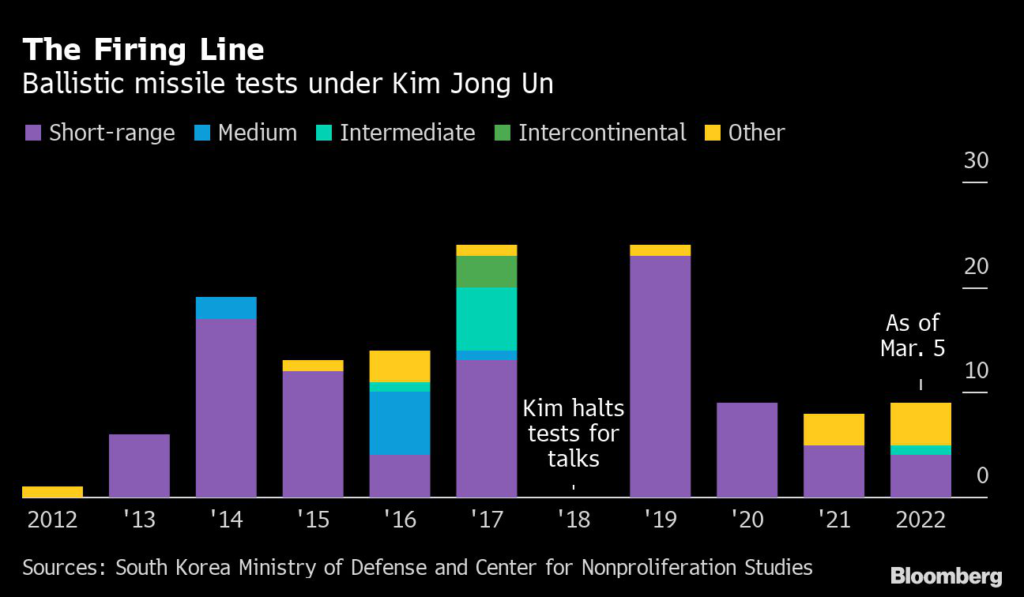(Bloomberg) — North Korea’s latest missile test appeared to have “failed” shortly after launch, South Korea’s military said, with the incident coming days after reports indicated that Kim Jong Un’s regime was preparing to fire its first ICBM since 2017.
The unidentified projectile appeared to have been launched at 9:30 a.m. Wednesday from an area near Pyongyang’s international airport, the Joint Chiefs of Staff said. The rocket seems to have exploded before reaching an altitude of 20 kilometers (12 miles), the Yonhap News Agency reported separately, citing an unidentified South Korean military official.
The rocket was launched from the same area where North Korea had in recent weeks reported test-firing satellite systems, which the U.S. said were actually part of an effort to develop a new intercontinental ballistic missile. South Korean authorities were undergoing additional analysis on the specifications of the missile tested Wednesday, a senior JCS official told reporters.
Loud sounds like those of an aircraft were heard in Pyongyang at the time of the launch followed by a crash, multiple witnesses told specialist service NK News. Another witness also reported seeing reddish smoke, the outlet said.
The U.S. Indo-Pacific Command condemned the launch of what it described in a tweet as a “ballistic missile” and said it was consulting closely with South Korea, Japan and other regional allies. While North Korea is banned by United Nations resolutions from conducting any ballistic missile tests, Kim may believe he can escape further penalties with traditional backers in Moscow and Beijing united against U.S.-led sanctions over Russia’s invasion of Ukraine.
Chinese Foreign Ministry spokesman Zhao Lijian said at a regular press briefing Wednesday in Beijing that China didn’t support any action that “escalates tensions” in the region. “We hope to see sustained peace and stability on the Korean Peninsula and believe all parties should make positive efforts to promote dialogue and peace talks,” he said.
The suspected launch comes as a new president, Yoon Suk Yeol, prepares to take power in South Korea. Yoon — a conservative, who takes office in May — has pledged to advance a hawkish line on foreign policy that would bolster the alliance with the U.S.
The U.S. has dispatched an aircraft carrier to the nearby Yellow Sea in response to the tests in recent weeks from North Korea.
While details of the launch remain sparse, a mishap could be North Korea’s biggest missile failure since August 2017, when a suspected ballistic missile broke into pieces. In April 2012, Kim’s regime test-fired a long-range rocket that disintegrated shortly after liftoff, an embarrassment for the state that came just ahead of the 100th anniversary of the birth of its founder, Kim Il Sung — the grandfather the current leader.
North Korea may now be preparing for a massive military parade to mark the 110th anniversary of his birth on April 15, according to reports based on satellite imagery. The country typically doesn’t comment on any test until a day after the event.
South Korea and the U.S. have detected signs of an imminent test of an intercontinental ballistic missile, Yonhap reported Sunday, citing unidentified South Korean government officials. The U.S. had said earlier that North Korean launches on Feb. 26 and March 4 were intended to test elements of an ICBM that weapons experts believe could be armed with multiple warheads.
North Korea’s last test of an ICBM was in November 2017, when it fired a Hwasong-15 with a range that experts said could strike all of the U.S. mainland. It was a major breakthrough in Kim’s efforts to deliver a nuclear weapon to any American city.
U.S. officials have said the latest tests point to a launch of the Hwasong-17, which is believed to be the world’s largest road-mobile missile of its kind. The weapon, which is bigger and likely has more powerful engines than earlier systems, was displayed at a military parade to mark the 75th anniversary of the ruling Workers’ Party in October 2020.
“Based on my read of the current set of indicators, I have little doubt that Kim Jong Un is ramping up his military modernization agenda, with a focus on ICBMs and new nuclear weapons designs,” said Ankit Panda, a senior fellow in the nuclear policy program at the Carnegie Endowment for International Peace.
(Updates with Chinese Foreign Ministry comment in sixth paragraph.)
More stories like this are available on bloomberg.com
©2022 Bloomberg L.P.











